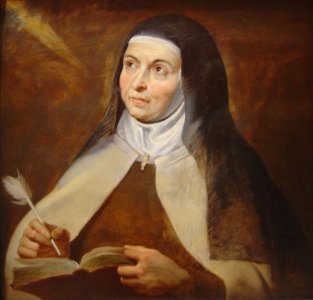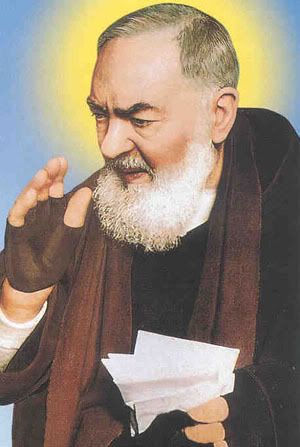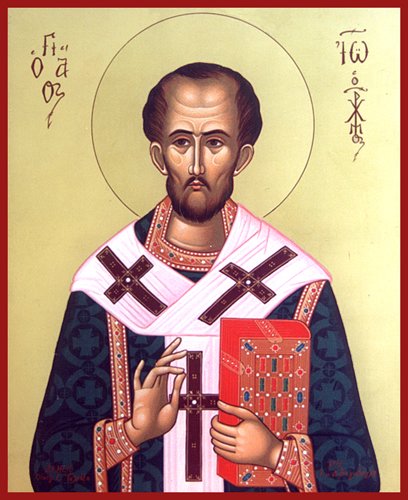
Mary Rose at
True Confessions of a Prodigal Daughter just posted a beautiful review about my saints' book. I think you'll find it interesting how she came to love the saints. Perhaps some of you can relate. Her review is here:
I've had the pleasure of meeting Donna-Marie Cooper O'Boyle online and have been touched by her dedication to encouraging women and celebrating overall her Catholic faith. She is a humble lady, simply wanting to share her love for God with everyone she meets. I can't fathom how she finds time to write since she has five wonderful kids and a husband. Talk about busy!
She sent me her book, Catholic Saints Prayer Book. It is a beautiful small volume, perfect for giving to a teacher or even your college-bound sons and daughters. (Giving college kids anything about saints is an excellent idea.)

The hardbound book is beautifully designed, with a lovely painting on the cover and illustrations inside. The pages are a soft gloss, with a calming green decorative border on the edges of each page. Donna-Marie managed to concisely capture the birth and death dates for each saint, their Feast Day, the saint's patronage, information about their life, and a prayer to that particular saint. Here is one of my favorites:
Prayer to St. Joseph
Dear St. Joseph, you were an ordinary man, a humble carpenter. But you were a prayerful, holy soul, the foster father of Jesus, a model for us all. Please guide me in my own journey through life, and help me be aware of God's specific call to me. Help me to see that in my own life God is calling me to greater things for His glory. Please pray to the Blessed Trinity for me to be granted the graces that I need most. I pray that I can be faithful to my state of life, totally trusting in God's divine providence for me. St. Joseph, pray for all who invoke your aid. If it is in God's holy will, please grant me (here mention your request). Amen.
Isn't that wonderful? I just love this little book of the saints.
I have to admit, appreciating the saints has taken some time. I have witnessed years of anti-Catholic perspectives. One of the biggest gripes Protestants and non-denominational believers have with Catholics is their presumed "praying to the saints." For years, I would declare, "There is no mediator between God and man but Jesus Christ." Of course, no one else could have redeemed us but Jesus Christ. No other sacrifice would do but a perfect one and Jesus Christ was the only one qualified to do it. He was, is, and shall be forever perfect, loving His heavenly Father with perfection, doing His will with complete surrender. No one can or should ever take the place of Jesus Christ.
However, I think my non-Catholic brothers and sisters misunderstand what is going on when Catholics venerate the saints. When prayers are offered up (I am partial to the very brief, "Pray for me, St. Joseph!") I am not worshipping St. Joseph, but asking St. Joseph to count me in his prayers and supplications before the throne of God.
Hebrews 12:1,2 says:
Therefore, since we are surrounded by so great a cloud of witnesses, let us also lay aside every weight, and sin which clings so closely, and let us run with perseverance the race that is set before us, looking to Jesus the pioneer and perfecter of our faith, who for the joy that was set before him endured the cross, despising the shame, and is seated at the right hand of the throne of God. (RSV)
You know, I've read those verses many, many times. I just thought the witnesses watched. But who could watch a race and not cheer? St. Paul was telling the Jewish believers that they had support. These verses took on fresh meaning as I realized those who have gone before us are now in heaven, praying for the Church to be perfected. Doesn't that make sense?
Aren't we asking the saints to put in a few prayers on our behalf that we would be made worthy of the promises of Christ? Of course. I still worship Jesus Christ for who He is and petition our Heavenly Father for all things. Scripture also tells us that the Holy Spirit makes intercession for us:
Likewise the Spirit helps us in our weakness; for we do not know how to pray as we ought, but the Spirit himself intercedes for us with sighs too deep for words. And he who searches the hearts of men knows what is the mind of the Spirit, because the Spirit intercedes for the saints according to the will of God. (Rom. 8:26, 27 RSV)
Ever since I've started to embrace the saints more, I have felt a new confidence enter my faith. I feel as though I do have a huge group of saints who are pulling for me. They know how difficult the journey can be and they are praying that we can overcome our trials and tribulations.
Donna-Marie's Catholic Saint Prayer Book is the perfect way to encourage others that they also have a group of saints who are "pulling for them" to persevere. It's a great gift for either yourself or someone you love. Enjoy it and be blessed! Click on the title to order.
(The above photos are from Mary Rose's blog)



































































